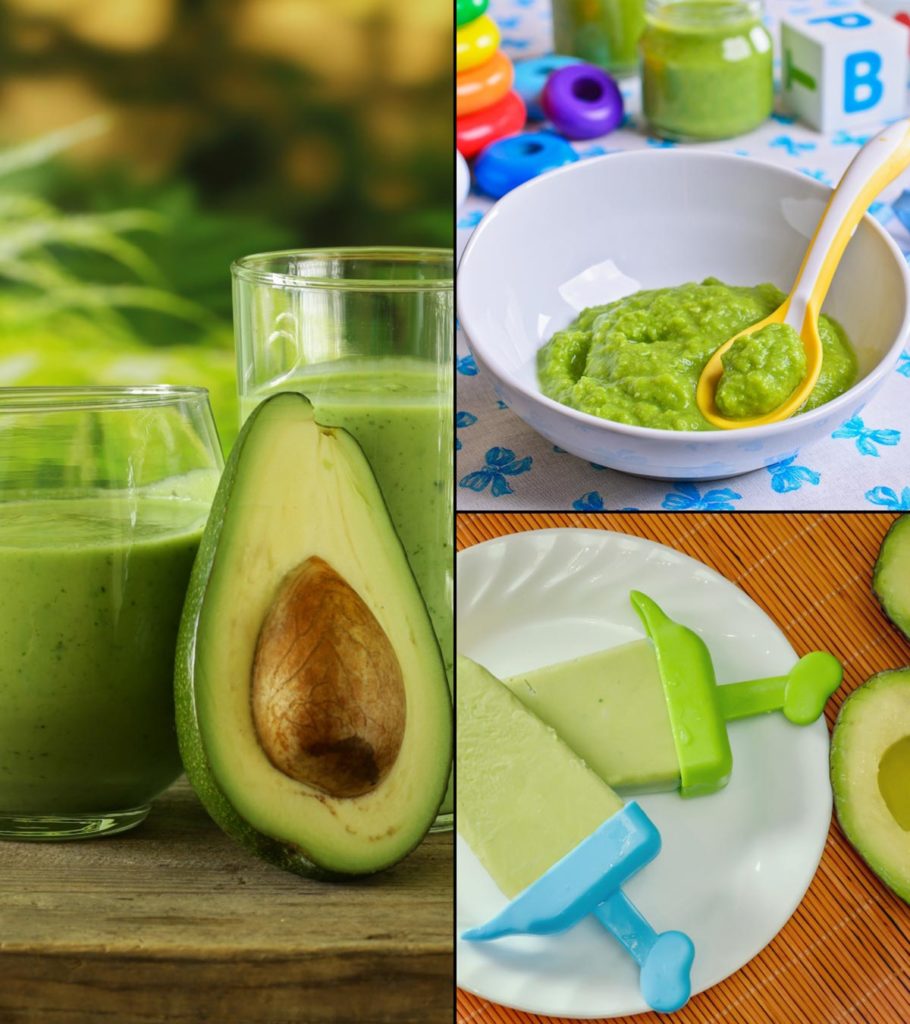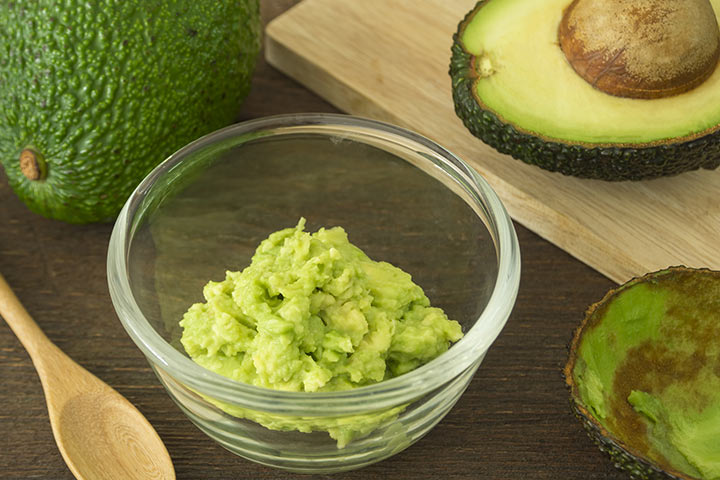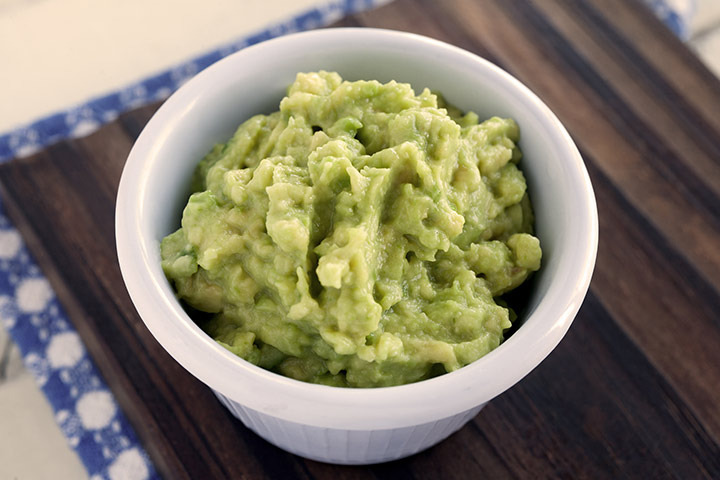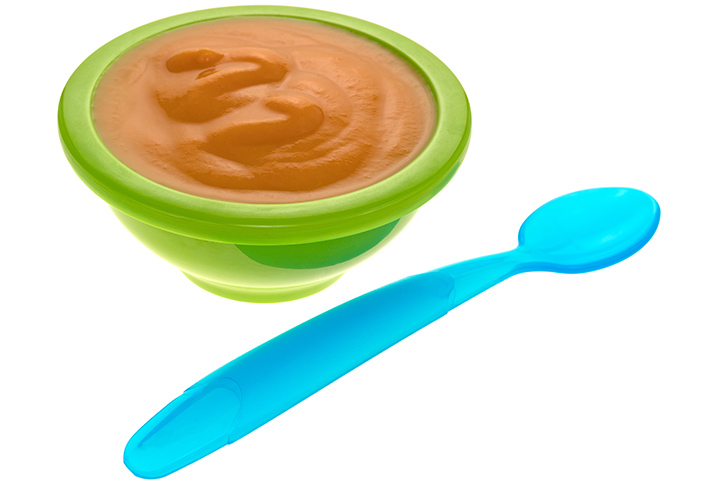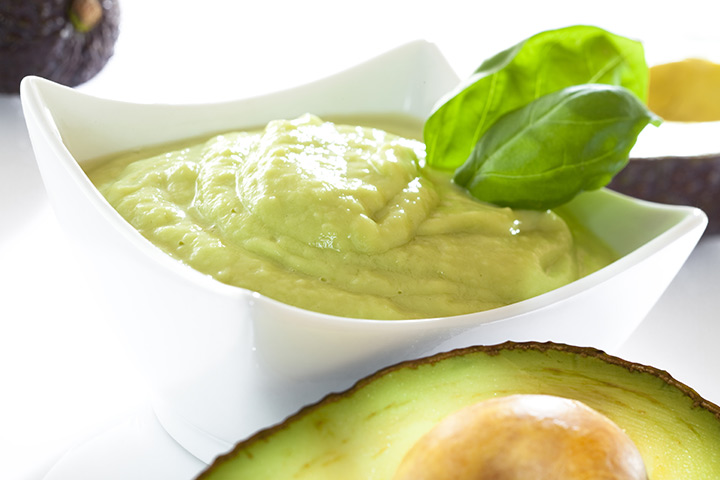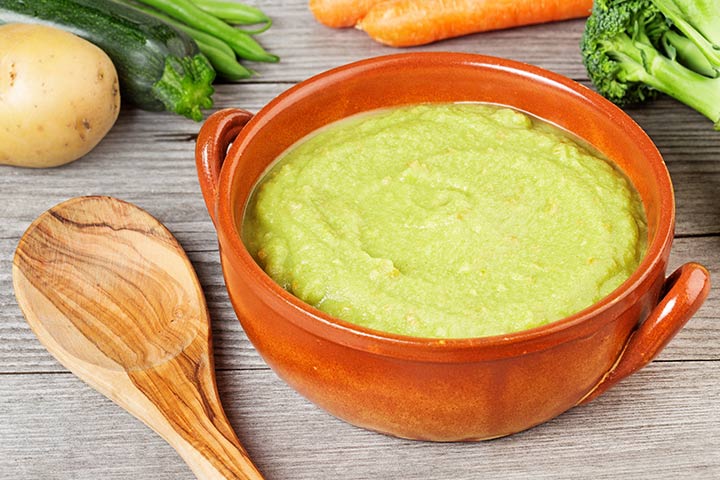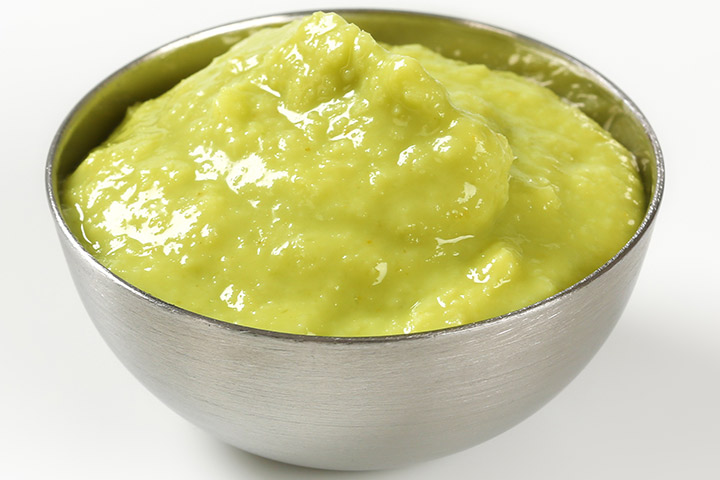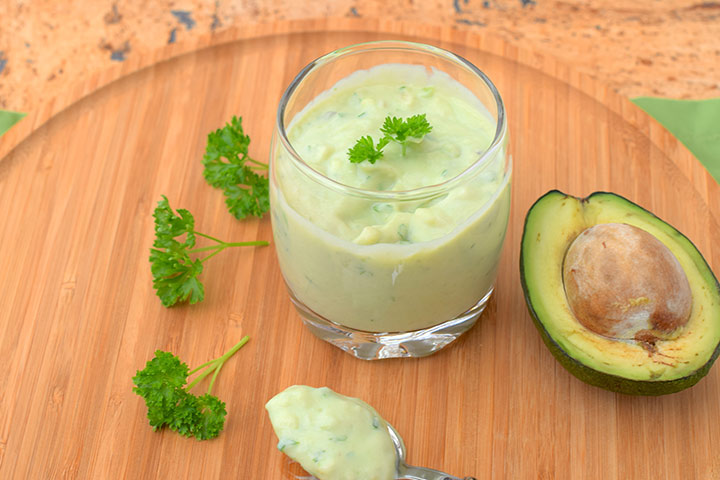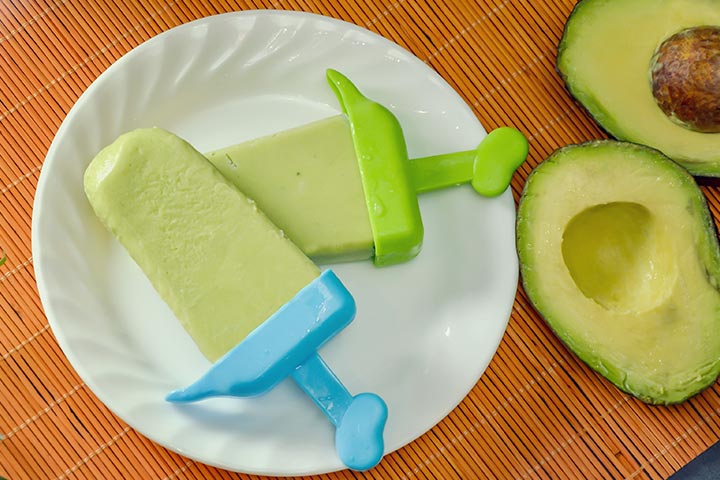Avocado is frequently used in baby foods because of its creaminess and easy-to-process pulp. Additionally, you may wish to introduce several avocado baby food recipes because they are high in essential nutrients, such as vitamins and minerals, and a balanced quantity of fats, all of which are important for a growing infant.
Many parents wonder whether avocado can be given as the first food to a baby who has just started eating solids. This article discusses various aspects of avocado for babies and provides the finest avocado-based baby food recipes.
When Can Babies Have Avocado?
Introduction to solids usually starts at six months of age and avocado can be the first food for your baby (1). While the creamy texture comes from fat, it is a “good” fat, and is vital for the baby’s growth. Avocados are also packed with several other vital nutritious ingredients, thus making it a superfood for babies.
Health Benefits Of Avocado For Babies
Your baby reaps the following health benefits when he eats avocado:
- Keeps the nervous system healthy: Avocado contains more folic acid (also called folateiXB vitamin vital for blood cells formation or vitamin B9) than many other fruits. Folic acid is essential for the healthy development of the nervous system. It also plays a vital role in brain development and boosting cognitive abilities. Regular consumption of avocado can act as a nervous system tonic for your little one (2).
- Provides good fat for growth: The fat found in avocados consists of monounsaturatediXA type of dietary fat fatty acids, which help in the growth and development of the body. This means you can feed your baby an avocado every day without worrying about them becoming overweight (3).
- Good for gross motor skills: An avocado has more potassium than a banana (4). A healthy intake of potassium is essential for proper functioning of the skeletal muscles (5). The health of the skeletal muscles, in turn, determines the progress of the gross motor skills.
- Boosts immunity: Avocados contain several micronutrients and vitamins. The fruit is rich in vitamin B6 that is vital for maintaining healthy immunity, which in turn protects the infant from a host of illnesses (6) (7).
- Improves eye health: Avocado is rich in antioxidants luteiniXAn oxygenated carotenoid present in vegetables and fruits and zeaxanthin that accumulate in the eyes and improve vision. These antioxidants also help protect the eyes from degenerative effects of the ultraviolet rays from sunlight (8).
Nutritional Value Per 100g Of Avocado
| Nutrient | Unit value per 100g |
|---|---|
| Energy | 160kcal |
| Carbohydrates | 8.53g |
| Natural sugars | 0.66g |
| Fiber | 6.7g |
| Protein | 2g |
| Fat | 14.66g |
| Calcium | 12mg |
| Iron | 0.55mg |
| Magnesium | 29mg |
| Phosphorus | 52mg |
| Potassium | 485mg |
| Sodium | 23mg |
| Manganese | 0.142mg |
| Copper | 0.19mg |
| Zinc | 0.64mg |
| Selenium | 0.4µg |
| Fluoride | 7µg |
| Vitamin C | 10mg |
| Vitamin B1 (Thiamin) | 0.067mg |
| Vitamin B2 (RiboflaviniXA B vitamin found in plant and animal-based foods) | 0.13mg |
| Vitamin B3 (Niacin) | 1.738mg |
| Vitamin B5 (Pantothenic acid) | 1.389mg |
| Vitamin B6 | 0.257mg |
| Vitamin B9 (Folate) | 81µg |
| CholineiXA vitamin B complex nutrient required for bodily functions | 14.2mg |
| Vitamin A | 7µg |
| Vitamin E | 2.07mg |
| Vitamin K | 21µg |
Source: United States Department of Agriculture (9)
Now, let’s look at some tips for cooking and storage of avocados.
How To Select And Store Avocados?
Selection: Avocados you buy in the market are often unripe. While it is okay for adults, babies will probably not like the slightly bitter taste of the unripe fruit.
- The best way to check if an avocado is ripe is to gently press it in the palm of your hand. A ripe avocado will feel firm, but yield a bit to the pressure from the hand (10). An unripe avocado will feel palpably hard, and an overripe one will crack or burst open when pressed.
- Choose avocados that have a dark green skin and a rough and bumpy feel.
- Observe the pulp once you cut an avocado at home. The pulp of a ripe avocado is light green and gets yellowish-green around the skin of the fruit.
Storage: It is best to consume sliced avocados fresh since the pulp is rich in fat and could be susceptible to bacterial degeneration. Sliced avocado can be stored in the form of purees and mashes. To do this, slice the avocados and turn them into puree, pour the puree into an ice cube tray, and freeze it (11). Consume it within a couple of days by thawing the fruit before eating.
Fresh fruit should be your first option since even the frozen avocado puree can lead to loss of nutrients.
Selecting and storing avocados is easy. And, in the next section, we tell you how to cook avocados for your baby.
How To Process Avocados For Baby Food?
Avocados are best eaten raw. Just like bananas, you remove the peel of the avocado and eat the pulp. Boiling or direct heating can make oils in the avocado pulp taste unappealing (12). However, you can bake and grill an avocado. You can also process the raw pulp for baby food. Here are the different ways to process avocados to instill baby-friendly flavors:
- You can grill avocados either on a conventional charcoal grill or in an oven. Cut the avocado into two, remove the seed, and cut the fruit lengthwise into thin slices. Grill the slices for three minutes. If you intend to cook in an oven, then preheat the oven to 400ºF (200ºC). Place the avocado slices on an oven grill and grill for ten minutes.
- To bake, cut the avocados the way you want – either slices or small chunks. Preheat the oven to 425ºF (218ºC). Bake the avocado for 20 minutes.
- Scoop out the pulp on a plate and use a fork to mash it. You can feed mashed pulp to the baby without any further processing.
- Pureeing the fruit is easy. Transfer the scooped pulp into a blender, add some water, and blend it till you attain a desired consistency.
- You can blend avocado with baby formula to add flavor to it.
Now, let’s take a look at a few recipes that use the above techniques of cooking the fruit.
Amazing Avocado Baby Food Recipes
Avocado makes an excellent accompaniment to several food items, thanks to its creamy texture and taste. Various food combinations using avocados can help in offering different textures and introducing new flavors to the baby. Here we present 11 delicious homemade baby food recipes using avocado.
1. Pear and avocado puree
This easy-to-prepare fruit puree combines pear’s subtle sweetness with avocado pulp’s creamy texture to create a delicious combination.
You will need:
- 1 pear
- 1 avocado
- 1-2 cups water
How to:
- Slice out the avocado pulp. Chop the pear into smaller pieces.
- Transfer it to a blender. Add water, and blend.
- To thicken the puree add a bit more avocado pulp and to thin it, add some water.
2. Avocado and banana mash
The sweetness of banana meets the creaminess of avocado to make this fruity dessert for your little one.
You will need:
- 1 banana
- 1 avocado
How to:
- Put the avocado pulp and the banana in a bowl. Mash them together with a fork.
- Add some water if the mixture gets mushy, or you can also add some formula milk.
- Once the mashed fruits attain desired consistency, the dish is ready to be served.
3. Sweet potato and avocado puree
Sweet potato goes well with avocado to make a nutritional baby food that naturally tastes sweet.
You will need:
- 2 cups diced sweet potato
- 1 avocado
- 4 cups of water
How to:
- Transfer the sweet potatoes into a cooking vessel along with water. Boil the sweet potatoes for 25 minutes. You can also pressure cook them for four whistles.
- Sieve out the sweet potatoes from the water and let it cool. Transfer the pulp of the avocado into a blender and add a cup of water.
- Add the boiled sweet potatoes to the blender and blend them. Pour more water if required and combine till you achieve the desired consistency.
4. Mango and avocado puree
You can combine the delicious tropical fruit with avocado to either make a puree or smoothie.
You will need:
- 1 mango
- 1 avocado
- 1 cup water
How to:
- Peel the mango and scoop out the pulp into a blender. Add the avocado pulp as well.
- Add some water and blend them till desired consistency.
- You can also add formula milk instead of water to make it into an avocado mango smoothie.
5. Chicken and avocado puree
Combine the protein-rich chicken with the good fat of avocado to make an avocado meal for your baby.
You will need:
- 1 1/2 cups of boneless chicken pieces
- 1 avocado
- 4-5 cups of water
How to:
- Boil the chicken for 25 minutes on medium flame or pressure cook it for up to four whistles from the cooker.
- Let the chicken cool. Do not discard the stock (the chicken water).
- Scoop out the pulp of avocado into the blender. You can add the pulp directly or bake it in an oven at 425ºF (218ºC) for 20 minutes.
- Transfer the avocado and the chicken, with its stock, into a blender.
- Blend until the chicken and avocado have adequately mixed.
6. Carrot and avocado puree:
Carrots are rich in vitamins thus making this combination of avocado and carrots an excellent multi-vitamin meal for an infant.
You will need:
- 1 cup diced carrots
- 1 avocado
- 3-4 cups of water
How to:
- Cook the carrots by boiling them in water for 20 minutes on a medium flame. You can also pressure cook it for three steam whistles.
- Cool the carrot with the stock.
- Transfer avocado pulp into a blender, add the carrots and the stock and blend till you achieve the desired consistency of the puree.
7. Peas and avocado mash
Mashed peas and avocado should surely be a green, delight packed with protein from peas and healthy fats from avocado.
You will need:
- 1 1/2 cups peas
- 1 avocado
- 2 cups of water
How to:
- Boil the peas for 25 minutes or pressure cook for up to three steam whistles.
- Sieve out the peas and let them cool. Do not discard the peas stock yet.
- Add the avocado pulp and the cooked peas in a bowl. Mash them together. If the mixture seems too thick, then add some peas stock to soften it.
8. Avocado and formula smoothie
If you love avocado smoothie yourself, then you can prepare some for your baby as well.
You will need:
- 1 medium-sized avocado
- 2-3 spoon formula
- 5-6 cups of water
How to:
- Slice the avocado into half, remove the seed, and use a spoon to scoop out the soft pulp.
- Transfer the pulp to a blender, add water, and formula to it. Do note that you can refer the back label of formula carton for the precise quantity of formula powder needed for a cup (236ml) of formula milk.
- Once you have all the ingredients in the blender, blend them. Pour into a cup and serve to the baby right away.
9. Apple and avocado puree
Apples go well with avocado and the two pack a lot of nourishment together for a healthy nutrition of your infant.
You will need:
- 1 apple
- 1 avocado
- 2-3 cups of water
How to:
- Chop the apple into smaller pieces and retain its skin since it contains a lot of nutrients.
- Transfer the apples to a cooking vessel with water to just submerge the apples. Cook for 25 minutes on medium flame.
- Let the apples cool along with the water.
- Add the avocado pulp into a blender and transfer the apple pieces with the water.
- Blend the avocados and apples finely together.
10. Avocado yogurt
A baby should not have cow’s milk before the age of 12 months, but it is okay to give yogurt. The American Academy of Pediatrics (AAP) states that processed dairy products such as yogurt can be introduced into a baby’s diet after six months and preferably in combination with a fruit or vegetable (13). It means you can combine avocado and yogurt to make a tasty digestion-friendly treat for your little one.
You will need:
- 1 1/2 cup whole cow’s milk yogurt (preferably homemade)
- 1 avocado
How to:
- Transfer yogurt to a blender and the avocado pulp to it.
- Blend till the avocado pulp entirely mixes with the yogurt.
- If the mixture seems thick, you can add a little water during the blending process.
11. Frozen avocado cubes
It makes an excellent avocado baby food for the hot summer months.
You will need:
- 3 avocados
- 4 cups of water
How to:
- Transfer the fruit pulp and water into a blender, and blend till it makes a very thick puree.
- Pour the puree into ice cube tray and freeze for an hour. The cubes must feel squishy and should not get too hard.
- Once ready, transfer to a plate and serve it to your toddler with another fruit such as with banana or you could even serve with yogurt.
In addition to the above recipes, you may feed avocado in combination with other fruits.
Avocado Baby Food Combinations
You can combine avocado with the following foods to make the most delicious baby food recipes:
- Fruits with innately sweet pulp such as bananas and mango taste the best with avocados. You can combine other fruits of your choice since avocado tastes good with almost any fruit.
- Make your baby’s formula interesting and flavorful with a dash of avocado.
- Yogurt will undoubtedly taste the best for an infant when combined with avocado.
- You can combine avocado with meat to bring that creamy texture to meat purees.
Avocado is a wonderful fruit that packs a lot of nourishment. But it might be unsuitable to some infants. Also, not all babies may like its taste.
Elizabeth, a mother of one, recounts her baby’s response to avocado. She says, “I was also really excited to put it (avocados) in Rex’s rotation because both Forrest (her husband) and I love avocados, and I thought it would be cool for him to indulge when we do.
“Well, unfortunately, Rex did not like the fatty fruit. Whenever he ate it, he gagged and coughed until we got the message and stopped shoveling the green gooey spoonfuls into his mouth (i).
Can A Baby Be Allergic To Avocados?
Yes. Infants can be allergic to avocado, and skins hives (medically called urticariaiXA skin reaction characterized by itchy bumps) is the most common symptom of avocado allergy. Other symptoms of avocado allergy are diarrhea, vomiting, nausea, swelling of the face, and drowsinessiXFeeling of sleepiness during the day.
If your infant is allergic to banana and melon, do not feed them avocado, as infants with allergies to these fruits are 90% likely to be allergic to avocado. If your baby has other allergies or allergic conditions such as asthma and eczemaiXA chronic, non-infectious skin ailment, then you can delay the introduction of avocados up to the age of nine months (14). Consult your pediatrician before introducing any new fruit into your baby’s diet and seek advice on using allergy-free recipes. In any case, be alert to the signs of avocado allergy in the baby.
You may have some more questions about the avocado fruit, and we address those queries in the section below.
Avocado is rich in protein, calcium, magnesium, healthy fat, and other nutrients. It is a good choice for babies over six months. You may offer them avocados in baked, grilled, or pureed forms. Its creamy and soft texture also allows you to create delicious avocado baby food recipes such as avocado and banana mash or mango and avocado puree. So, if your baby is not allergic to avocados, feed them the fruit daily to keep their nervous system healthy, help develop gross motor skills, and boost immunity.
Key Pointers
- Avocados provide essential fiber, minerals, and vitamins for a baby’s growth and development.
- Introduce avocados to babies after they are 6 months old.
- Avocados can be mashed or pureed to create a smooth texture or cut into small pieces for finger food.
- Avocados can be combined with other foods, such as fruit purees, vegetables, or grains, to create a balanced and nutritious meal for babies.
Unleash your creativity with four delightful and nutritious homemade baby food avocado recipes—learn how to prepare healthy and easy meals for your little bundle of joy.
